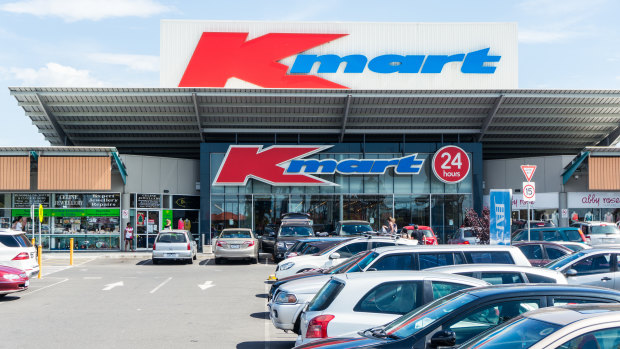Home » World News »
Burwood was never the high point of style, but it did introduce the world to Kmart
Save articles for later
Add articles to your saved list and come back to them any time.
Not realising how dramatically the tides of real estate fashion would change, the move from leafy Glen Iris to Burwood made perfect sense in 1973.
My parents were abandoning our old weatherboard Californian bungalow in search of a third bedroom and affordable, low-maintenance brick-veneer. The promised tram extension along Burwood Highway sealed the deal.
The first Kmart to ever open in Australia was in Burwood.Credit: iStock
Despite my initial excitement, our new abode was never a high point of mid-century style. Its 1964 fake gold-leaf mini chandeliers, metal-fleck bathroom vanity and floral wallpaper were already an outdated reminder of fussy suburban tastes. My uncle’s house, bought a little later in Vermont South, seemed infinitely more up to date, with its soaring cathedral ceilings, earthy tones, faux-rustic light fittings and acres of fluffy orange carpet.
Indeed, what Burwood had, in contrast to more established enclaves that trade on their manicured heritage chic, was an uncritical preparedness to welcome the latest and greatest, however quickly it would fade.
The most dramatic example of this was Burwood Skyline, Australia’s first drive-in movie theatre, built in 1954, just across from where the steeples of Deakin University’s shimmering cathedral to international education now stand. Until 1983, you could drive down Burwood Highway to view whatever family fare was screening. With capacity of over 600 cars, the baby boom was in full swing. Now, the whole area is a Suburban Rail Loop construction site.
My conservative migrant family never went to the drive in, but fortunately the local Kmart, another first for Australia, was just a little further down the eponymous highway that bisects the suburb. Opened in 1969, it was a sleek, low-slung, single-level retail showcase where I purchased a youthful Daryl Somers’ Hey! Hey! It’s Daryl and Ossie LP, and then my first single, Dancing Queen. Later, a wood-veneer clock radio introduced me to a new decade’s soft rock sounds by Leo Sayer and Air Supply. Before snooty café culture shamed it out of existence, Kmart even boasted a cafeteria, Holly’s, furnished with diner-style booths.
With rising land prices, the complex has been substantially redeveloped, but in the ’70s and ’80s, depending on the season, outdoor car parking sprawled out into sun-scorched and wind-swept infinity.
For kids without parental transport, a closer option was the local shopping strip, opposite the RSPCA. A one-cent coin bought two lollies at the milk bar, including the now politically suspect Big Boss cigars and imitation cigarettes called Fags. You could also buy fire crackers there before children made a habit of blowing them up in each other’s pockets.
Without even a public library or a pub, it wasn’t difficult for families to outgrow Burwood’s limitations. For more serious retail forays, a lurching Ventura bus was the ticket to nearby Box Hill, where the cacophony of level crossing bells still halted traffic across Station street. Though it wasn’t the mini CBD it has since become, it was our bustling centre of white-bread suburbia.
Until 1980, I suffered the humiliating purgatory of discount-store jeans that lacked a cherished brand-name tag. But in 1980, I made the pilgrimage to Box Hill Plaza to buy my first pair of long-awaited brown-corduroy Levis from the groovy, darkened, shag-pile-carpeted change rooms of Just Jeans. Paired with suede desert boots, $23 finally secured adolescent legitimacy.
On the way home, I suffered the consequences of venturing beyond Burwood’s safe confines. Waiting at the ground-level bus depot, I was hit across the face by a scowling sharpie, a local tough wearing skin-tight, high-riding jeans and a close-fitting cardigan. He had demanded one of my potato cakes, but I refused.
Years later, having ironically survived New York’s ’hoods without a similar incident, I reflected on the eerie suburban silence in my mother’s dining room. The term “dormitory suburb” was made for this place, and I was falling asleep.
Shifting demographics also played their part. Streets that once reverberated with the sounds of children playing and going to schools that have long since closed are now distant echoes of the past. Students of Deakin University now crowd into mushrooming multi-unit developments and ageing share houses with neglected gardens.
Sated by further travels, over time I eventually came to find a new appreciation of the peace and quiet of Burwood.
Upon my mother’s later move to a nursing home, all I was left with were memories of her modest home and the unassuming suburb I knew. Save for a brush with 1980s pastels, most of our house’s old-fashioned features remained, packed with her treasures. At more than 90 years of age, she still thinks it’s there and intact, awaiting her eventual return.
This piece is part of The Age’s Life in the ’Burbs series.
The Opinion newsletter is a weekly wrap of views that will challenge, champion and inform your own. Sign up here.
Most Viewed in National
From our partners
Source: Read Full Article



